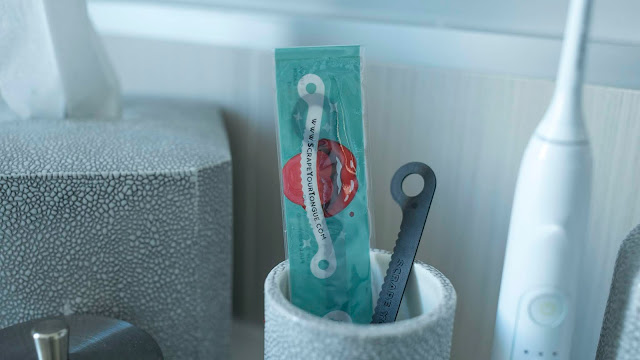
Is Tongue Scraping the Secret to Staying Young?
Share
Experts back the science, and it sure beats expensive creams or pills
_______________________________________________________________________
When we’re younger, getting older doesn’t seem like a big deal.
Honestly, it’s freakin’ awesome. Our bodies seem invincible – we can go out drinking all night, stuff our faces with junk food, and pull all-nighters…and still look totally fabulous the next morning.
But as soon as we hit 30, things start to…change. Our alcohol tolerance goes down, we start noticing gray hairs, and – are those wrinkles on your forehead? Yikes!
If you’re a man, don’t think for one second that the anti-aging market is just for women. More and more men are seeking the fountain of youth as well, so much so that the anti-aging market is expected to reach $216 billion by 2021 in the U.S. alone.
But slowing down the aging process doesn’t have to be expensive (or painful!). In fact, we think it should only cost $1.
Ok, So What’s the Secret?
Tongue Cleaner
Tongue Brush
Tongue Comb
Whatever you call it - this simple device with handles on either side and ridges along the center is the answer to staying young and healthy: |
Before you dismiss tongue scraping as medical quackery or voodoo science, what we’re about to tell you has been backed by scientific research.
Tongue scraping is a 2,000-year-old practice that can remove harmful bacteria and food debris from the surface of your tongue. This creates a healthy balance of bacteria in your mouth, which some experts say is the key to youth.
So not only will your breath smell better, scraping your tongue will improve the function of your taste buds AND will keep you looking youthful.
How Does Tongue Scraping Keep You Young?
The secret to anti-aging appears to be a small molecule called nitric oxide.
According to Dr. Nathan Bryan, a professor at the Baylor University School of Medicine, nitric oxide is the “holy grail” of medicine.
In his book, Functional Nitric Oxide Nutrition: Dietary Strategies to Prevent and Treat Chronic Disease, he writes that loss of nitric oxide can lead to poor cardiovascular health as people age.
Studies have shown that nitric oxide levels in people over the age of 40 are only about half of those in younger people. Women unfortunately fare worse when it comes to declining nitric oxide levels, producing only 35% of what they did in their twenties by the time they reach 50.
This drop in nitric oxide not only leads to disease, but also appears to prevent our bodies from healing effectively – hence the dreaded signs of aging.
But Dr. Bryan’s research suggests that not all hope is lost.
Since up to 50% of our daily nitric oxide production is from the “good” oral bacteria, helping them thrive with regular tongue scraping could help produce more nitric oxide -- keeping you looking and feeling younger for longer.
More About Nitric Oxide
Having spent much of his academic career studying this one molecule, Dr. Bryan has come to appreciate the critical roles nitric oxide plays in the body.
To get a better understanding of how nitric oxide helps keep you young, we have to dig deeper into the aging process.
Scientists say there are 3 main themes to the aging process: 1) The shortening of telomeres at the end of chromosomes; 2) Mitochondrial dysfunction; and 3) Inefficiency of stem cells to repair damage.
1) Telomeres
Telomeres are structures at the end of a chromosome that protect our DNA from deterioration and make it possible for cells to divide. Unfortunately, telomeres get shorter and shorter every time cells divide, allowing errors to creep in during DNA replication. If the telomeres get too short, the cells stop dividing and may die.
An enzyme called telomerase can counteract telomere shortening, but there is not enough telomerase for every cell in our bodies.
2) Mitochondria
To make matters worse, mitochondria – often called the powerhouse of cells – stop working as well as they used to. Mitochondrial dysfunction has been linked to cellular senescence, chronic inflammation, and decline in stem cell activity.
Scientists are researching mitochondrial-targeted therapies to slow or reverse the aging process.
3) Stem Cells
Researchers have also linked degenerative changes in stem cells to aging tissues and declining regenerative capacities.
Young people have many more stem cells than older people, allowing for a more efficient repair and regenerative mechanism.
It All Comes Back to Tongue Scraping
via GIPHYDr. Bryan states that nitric oxide plays a key role in all of these processes. He said, “Nitric oxide controls telomerase…nitric oxide controls mitochondria biogenesis. And nitric oxide is the cellular signal that tells stem cells to mobilize to repair damage.”
Our bodies convert nitrates taken in by food or supplements into nitric oxide. A good diet and supplementation is a good start, but they might not be enough. According to Dr. Bryan, this complicated conversion requires the right oral microbiome.
And the most efficient way to do this? Tongue scraping.
The 100%-recyclable plastic Tongue Scraper from ScrapeYourTongue.com is just $4 (or $1 if you subscribe to receive a new one each month) and is the most effective one. Its unique design allows for you to cover the entire surface area of your tongue with one scrape and it doesn’t set off your gag reflex because you’re holding it with both hands at either end.



